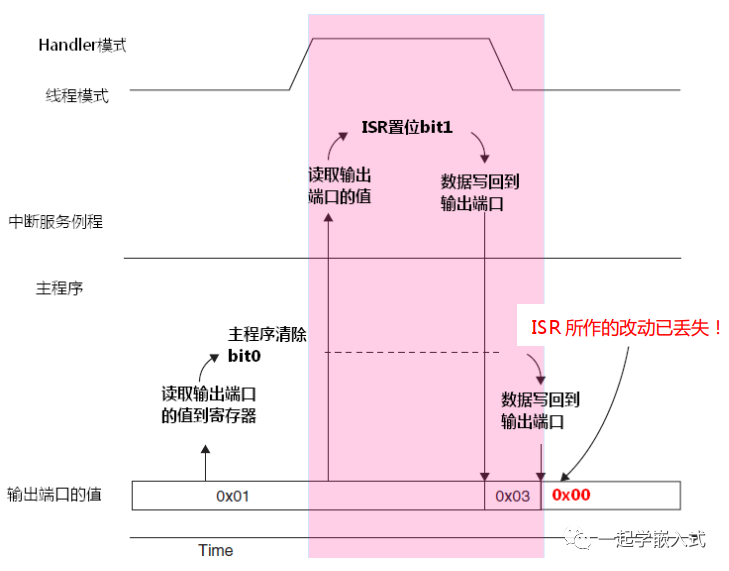Let’s talk about:
Before introducing bit-band operations, let’s first look at the memory mapping of the ARM Cortex-M3.
The address space of CM3 is 4GB, and programs can execute in the code area, internal SRAM area, and external RAM area.
The program memory, data memory, registers, and input/output ports of STM32 microcontrollers are organized within the same 4GB linear address space. Data bytes are stored in memory in little-endian format.

CM3 uses the following terminology to represent addresses related to bit-band storage:
-
Bit-band region: The address region that supports bit-band operations
-
Bit-band alias: Access to the alias address will eventually convert to access to the bit-band region (Note: There is an address mapping process)
The Cortex-M3 memory map includes two bit-band regions. These two bit-band regions map each word in the alias memory region to a bit in the bit-band memory region, writing a word in the alias storage has the same effect as executing a “read-modify-write” operation on the target bit in the bit-band region.
The two bit-band regions are:
-
The first is the lowest 1MB range of the SRAM region, with an address range of 0x2000_0000-0x200F_FFFF -
The second is the lowest 1MB range of the on-chip peripheral region, with an address range of 0x4000_0000-0x400F_FFFF
In addition to being used like ordinary RAM, the addresses in these two bit-band regions also have their own “bit-band alias regions,” which expand each bit into a 32-bit word. When you access these words through the bit-band alias regions, you can achieve the goal of accessing the original bits.
The correspondence between the bit-band region and the bit-band alias region is shown in the figure below:

In the bit-band region, each bit is mapped to a word at an alias address, which is a word where only the LSB is valid. When an alias address is accessed, it is first converted to the bit-band address.
In STM32F10xxx, peripheral registers and SRAM are both mapped to a bit-band region, allowing single-bit read and write operations.
The following mapping formula shows how each word in the alias region corresponds to the respective bit in the bit-band region:
bit_word_addr = bit_band_base + (byte_offset × 32) + (bit_number × 4)-
bit_word_addr is the address of the word in the alias memory region, which maps to a target bit -
bit_band_base is the starting address of the alias region -
byte_offset is the index of the byte containing the target bit in the bit-band -
bit_number is the position of the target bit (0-31)
For example, how to map the bit 2 of the byte in the SRAM address 0x20000300 in the alias region.
0x22006008 = 0x22000000 + (0x300 × 32) + (2 × 4)The write operation to address 0x22006008 has the same effect as executing a “read-modify-write” operation on bit 2 of the byte at SRAM address 0x20000300.
-
For read operations, first read a word from the bit-band address, then right shift the needed bit to the LSB, and return the LSB.
-
For write operations, shift the bit to be written to the corresponding bit position, and then perform an atomic “read-modify-write.”
-
Read the entire register
-
Mask out the unnecessary bits
-
Compare and jump
-
Read the status bit from the bit-band alias region
-
Compare and jump

#define DEVICE_REG0 ((volatile unsigned long *) (0x40000000))
#define DEVICE_REG0_BIT0 ((volatile unsigned long *) (0x42000000))
#define DEVICE_REG0_BIT1 ((volatile unsigned long *) (0x42000004))// Macro to convert “bit-band address + bit number” to alias address
#define BITBAND(addr, bitnum) ((addr & 0xF0000000)+0x2000000+((addr & 0xFFFFF)<<5)+(bitnum<<2))
// Convert the address to a pointer
#define MEM_ADDR(addr) *((volatile unsigned long *) (addr))Therefore, it is necessary to use volatile, so that the compiler writes the new value to memory every time, rather than optimizing and using a register to operate on a copy of the data, and only writing back the copy at the end — this can lead to inconsistent results when accessing the same bit in different ways.
In conclusion:
In the actual development of STM32 microcontrollers, it is generally recommended to use the standard library or HAL library, and we can directly use the APIs provided by the library to complete the corresponding tasks, which means the library helps us complete the bit-band conversion.
We have mastered the principles of bit-band operations, understanding both the what and the why. If we encounter related issues, we can analyze and solve them from a theoretical perspective.
Source: Learn Embedded Together
Due to recent changes in WeChat public platform push rules, many readers have reported not seeing updated articles in time. According to the latest rules, it is recommended to click “Recommended Reading, Share, Collect” more often to become a regular reader.
Recommended Reading:
-
4 years burned 17 billion, another new car force goes bankrupt!
-
Xiaomi’s first electric vehicle starts at 149,900, cost-effective!
-
Huawei adds 3 patent licensing plans! Netizens: The fees are too low
Please click 【Looking】 to give the author a thumbs up
